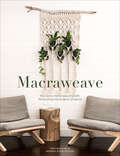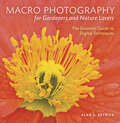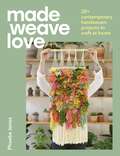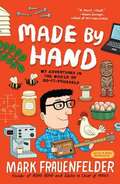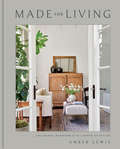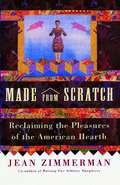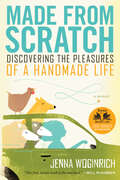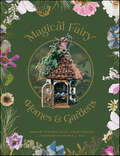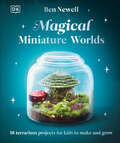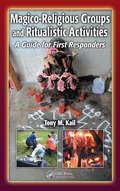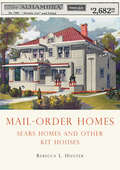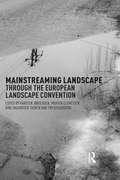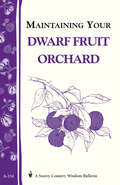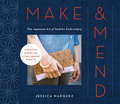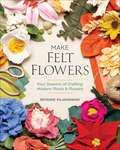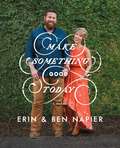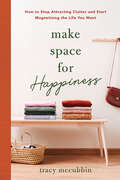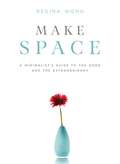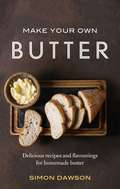- Table View
- List View
Macraweave: Macrame Meets Weaving with 18 Stunning Home Decor Projects
by Amy Mullins Marnia Ryan-RaisonDiscover the exciting new craft that brings together two timelessly popular fiber arts to make beautiful, eye-catching pieces for your home. Learn to create stunning woven wall hangings and inject a dose of &“bohemian luxe&” to your living space. Macraweavecombines the crafts of macramé knotting with weaving to create eye-catching projects that really pop with texture and color. There are eighteen projects to choose from including woven wall hangings, table mats, plant hangers and cushions as well as accessories such as jewelry. All the instructions and projects are illustrated with step-by-step photography.
Macro Photography for Gardeners and Nature Lovers: The Essential Guide to Digital Techniques
by Alan L. DetrickGardeners and nature lovers delight in taking pictures—especially close-ups of flowers, butterflies, and insects. And though advances in digital camera technology have made taking, storing, and sharing photos easier than ever, taking top-quality pictures requires familiarity with both digital technology and the general principles of photography. Macro Photography for Gardeners and Nature Lovers provides exactly the information that aspiring photographers—no matter their level of skill—need to take their photos to the next level. Clear and concise chapters cover the basics of macro (close-up) photography, explain the features of current digital single-lens reflex cameras, show the many ways images can be composed, and share tips on digital effects, storage, and manipulation of imagery. Throughout the text, helpful tips, definitions, exercises, and case studies serve to demystify digital photography. Each lesson is supported by examples of the author's stunning photography. Whether taking photos of flowers and insects, compiling a photographic record of your garden, or simply sharing beautiful images with friends and family, everyone can become accomplished photographers of the world's small-scale wonders.
Made Weave Love: 20+ contemporary handwoven projects to craft at home
by Phoebe JonesMaster the art of weaving with over 20 stunning projects Phoebe Jones is on a mission to make weaving accessible to all. In her debut book Made Weave Love Phoebe shows you the joys of weaving and how this gentle and intuitive craft can spark creativity in your life. Covering the very basics from the essential tools and how to build your own loom, to selecting the perfect yarn and finding colour and design inspiration, Phoebe carefully guides you through everything you need to get started.Packed with beautiful photography and step-by-step tutorials throughout, this go-to guide - featuring projects for both beginners and advanced crafters alike - will give you the skills you need to confidently weave gorgeous masterpieces that spread style and colour throughout your home.
Made Weave Love: 20+ contemporary handwoven projects to craft at home
by Phoebe JonesMaster the art of weaving with over 20 stunning projects Phoebe Jones is on a mission to make weaving accessible to all. In her debut book Made Weave Love Phoebe shows you the joys of weaving and how this gentle and intuitive craft can spark creativity in your life. Covering the very basics from the essential tools and how to build your own loom, to selecting the perfect yarn and finding colour and design inspiration, Phoebe carefully guides you through everything you need to get started.Packed with beautiful photography and step-by-step tutorials throughout, this go-to guide - featuring projects for both beginners and advanced crafters alike - will give you the skills you need to confidently weave gorgeous masterpieces that spread style and colour throughout your home.
Made by Hand
by Mark FrauenfelderMark Frauenfelder, cofounder of Boing Boing, the world's most popular blog, goes on a do-it-yourself journey to prove that handmade is a more satisfying way to live.
Made for Living: Collected Interiors for All Sorts of Styles
by Amber Lewis Cat ChenThe trendsetting designer known for her effortless style shares the secrets of the art of layering, with more than 250 gorgeous photographs of her signature interiors. &“Livability is my true north. The materials I use time and again all change with age and wear. Not only is that okay, it&’s how you achieve more than a re-creation of what you&’ve already seen, or what somebody else has done. You can do this, too—I promise.&”—from the introduction Designing a room with all the vibes comes down to how you layer your décor. The more you can mix the elements of your room—your pillows, objects, patterns, and lighting—the more finished it&’ll feel: not too new, not too old, but just right. Known for her eclectic approach that stems from her California cool, Amber Lewis trains your eye in Made for Living, offering friendly advice on everything from nailing that perfect shade of paint to mismatching patterns with wild abandon to choosing a stone finish for new countertops. These pages will help you design a home that's made to be lived in.
Made from Scratch
by Jean ZimmermanIn this stunning celebration and reappraisal of the importance of "women's work," acclaimed journalist Jean Zimmerman poignantly addresses the tug that many Americans of the twenty-first century feel between our professional and private lives. With sharp wit and intelligence, she offers evidence that in the current domestic vacuum, we still long for a richer home life -- a paradox visible in the Martha Stewart phenomenon, in the continuing popularity of women's service magazines such as Better Homes and Gardens, Family Circle, and Ladies' Home Journal -- whose combined circulation of over 17 million is nearly twice the combined circulation of Time, Newsweek, and U.S. News & World Report -- and the booming business of restorations, where onlookers get a hands-on view of domestic life as it flourished in past centuries. This book is about the ways home traditions passed from one generation to the next -- baking a birthday cake from scratch, cherishing family heirlooms, or discovering the satisfaction of piecing a quilt -- sustain our souls, especially in our ever more processed, synthetic world, where we buy "homemade" goods and fail to see the irony in that.Made from Scratch tells the story of the unsung heroines of the hearth, investigating the history of female domesticity and charting its cultural changes over centuries. Zimmerman traces the lives of her own family's homemakers -- from her tiny but indomitable grandmother, who managed a farm, strangled chickens with her bare hands, and sewed all the family clothing, to her mother, who rejected her country upbringing yet kept a fastidious suburban home where the gender divide stayed firmly in place, to her own experiences as a wife and mother weaned on the Women's Movement of the 1970s, with its emphatic view that housework was a dirty word and that the domestic sphere was to be fled rather than cherished. In this book Zimmerman questions the unexamined trade-off we have made in a shockingly brief time span, as we've "progressed" from home-raised chickens to frozen TV dinners to McNuggets from the food court at the mall. What is lost when we no longer engage, as individuals and as a community, in the ancient rituals of food, craft, and shelter?
Made from Scratch: Discovering the Pleasures of a Handmade Life
by Jenna WoginrichIn a hectic world of mass-produced food, clothing, and entertainment, it’s easy to miss out on the simple pleasures of doing things for yourself. Young web designer Jenna Woginrich chronicles her adventures as she learns to embrace the idea of self-sufficiency in all aspects of her life, including sewing her own clothes, growing her own food, and creating her own fun outside of the mainstream. Woginrich’s hilarious, heartbreaking, and soul-satisfying journey will bring joy and inspiration to those who dream about a more independent lifestyle.
Made from Scratch: Reclaiming the Pleasures of the American Hearth
by Jean ZimmermanA stunning celebration and reappraisal of the importance of "women's work," Made from Scratch addresses the tug that many Americans feel between our professional and private lives. In this stunning celebration and reappraisal of the importance of "women's work," acclaimed journalist Jean Zimmerman poignantly addresses the tug that many Americans of the twenty-first century feel between our professional and private lives. With sharp wit and intelligence, she offers evidence that in the current domestic vacuum, we still long for a richer home life -- a paradox visible in the Martha Stewart phenomenon, in the continuing popularity of women's service magazines such as Better Homes and Gardens, Family Circle, and Ladies' Home Journal -- whose combined circulation of over 17 million is nearly twice the combined circulation of Time, Newsweek, and U.S. News & World Report -- and the booming business of restorations, where onlookers get a hands-on view of domestic life as it flourished in past centuries. This book is about the ways home traditions passed from one generation to the next -- baking a birthday cake from scratch, cherishing family heirlooms, or discovering the satisfaction of piecing a quilt -- sustain our souls, especially in our ever more processed, synthetic world, where we buy "homemade" goods and fail to see the irony in that.Made from Scratch tells the story of the unsung heroines of the hearth, investigating the history of female domesticity and charting its cultural changes over centuries. Zimmerman traces the lives of her own family's homemakers -- from her tiny but indomitable grandmother, who managed a farm, strangled chickens with her bare hands, and sewed all the family clothing, to her mother, who rejected her country upbringing yet kept a fastidious suburban home where the gender divide stayed firmly in place, to her own experiences as a wife and mother weaned on the Women's Movement of the 1970s, with its emphatic view that housework was a dirty word and that the domestic sphere was to be fled rather than cherished. In this book Zimmerman questions the unexamined trade-off we have made in a shockingly brief time span, as we've "progressed" from home-raised chickens to frozen TV dinners to McNuggets from the food court at the mall. What is lost when we no longer engage, as individuals and as a community, in the ancient rituals of food, craft, and shelter?
Magical Fairy Homes and Gardens
by Barbara Purchia E. Ashley RooneyFairies—those mythical sprites of folktales and daydreams—are an enduring source of fascination to humans. Designing, creating, and maintaining fairy dwellings and gardens has become popular as an artistic endeavor, family activity, or form of meditation. Published in 2014, Purchia and Rooney's Fairy Homes & Gardens has transported thousands of readers to the magical realm of fairy gardening. In the ensuing years, fairy homes and gardens have become much more than a fleeting trend, establishing a perennial pastime for people of all ages. A treasure trove of ideas, this inspiring follow-up features • images and stories of more than 50 new projects that encompass a wide variety of fairy dwellings—communities, cottages, houses, castles, chalets, and other serendipitous structures, • creations by more than two dozen of the most talented and innovative artists creating fairy environments, • a special chapter on fairy accessories, including furniture, doors, swings, and the other creature comforts that fairies appreciate, • an appendix spotlighting plants that are ideal for incorporation into fairy gardens, and • a foreword that tells the story of Florence Griswold Museum's wildly popular Wee Faerie Garden event. Appealing to fairy enthusiasts and nature lovers of all ages, this book provides bold inspiration to help readers embark on a creative and relaxing pursuit that takes them directly into the world of fairy magic.
Magical Miniature Worlds: 18 Terrarium Projects for Kids to Make and Grow
by Ben NewellJoin expert Ben Newell and learn how to create your own tiny world in this children’s terrarium book.This plant book for children aged 7-9 offers practical instructions and loads of exciting ideas for making your own terrarium.Ben Newell clearly explains every step of creating your own terrarium, from picking a container to creating a landscape and choosing the right plants. Once you've mastered the basics, you can let your imagination run wild with these miniature gardens that can be grown in anything from fish tanks to spice jars.This gardening book for kids offers: Content made by terrarium expert Ben Newell. 18 terrarium projects that can be made in any space or environment. Clear, practical guidance and step-by-step instructions on how to build a terrarium.A variety of projects that are themed, including a fairy house, alien landscape, and egg hunt.Why not build a prehistoric jungle complete with dinosaurs? Or a delicate fairy garden? Maybe even an alien world? With 18 different projects to inspire you, you'll be filling your shelves in no time. As well as building terrariums, you'll discover how they work, including all about friendly soil creatures and the water cycle. By learning some of the science behind terrariums, you'll make sure that yours thrives.
Magico-Religious Groups and Ritualistic Activities: A Guide for First Responders
by Tony M. KailMore than just a litany of artifacts, rituals, and symbols, this valuable book provides a cultural bridge for emergency responders. It places the information in a relevant context and offers crucial keys to communication, assessment, and treatment in culturally sensitive situations. Beginning with the importance of trans-cultural communication, the book separates fact from fantasy regarding Neo-Paganism, Santeria, Bantu religion (Palo Mayombe), Voodoo, and Curanderismo. Promoting functional cultural competency, this book provides the tools to properly assess situations, open lines of communication, protect cultural diversity, and provide effective emergency treatment.
Mail-Order Homes
by Rebecca HunterAt the turn of the last century, the American middle class was expanding rapidly as homesteaders moved west and as trains took travellers across the country, where they established themselves in the depot towns that erupted along train lines. With that growth came the demand for new homes, and from that demand grew a new industry: mail-order homes. Sold by such makers as Sears, Roebuck & Co., Aladdin, and Montgomery Wards, these kit homes were shipped by train, arriving in two boxcars, which then were off-loaded by the purchasers, usually with a team of horse and wagon. In the boxcars was absolutely everything needed to assemble a house, whether it be a vacation cottage, modest bungalow, or two-and-a-half storey home. Literally tens of thousands of these affordable homes were sold in the early 1900s, with most built between 1910-40. In Mail-Order Homes, historical architectural researcher Rebecca Hunter brings to life the history of these charming homes, many of which still stand in communities across the country. From the manufacturers of mail-order homes to the customers who bought and built them, and from the styles and designs to the boom and bust of the industry, Hunter explains the history of these forgotten homes. Filled with illustrations from mail-order home catalogs and contemporary photos, this book tells the story of a bygone era of residential architecture.
Mainstreaming Landscape through the European Landscape Convention
by Tim Richardson Morten Clemetsen Anne-Karine Halvorsen Thoren Karsten JorgensenThe European Landscape Convention has introduced a Europe-wide concept of protection, management and planning of all landscapes - not just the outstanding ones. This book reflects on the background to the establishment of the convention, takes a critical look at examples and experiences of its implementation, and discusses future developments for the convention and the management of landscapes in Europe. A decade after the creation of the European Landscape Convention, this book asks how it has influenced the governance and development of European landscapes, and what role it will play in the coming years. The authors provide a wide range of analyses, reflections and visions, informed by their diverse experiences of researching, working with and using the convention. The sixteen essays are organised into three sections, focusing on the fundamental concepts and values behind the convention, current projects and experiences of implementation, and prospects for future developments.
Maintaining Your Dwarf Fruit Orchard: Storey's Country Wisdom Bulletin A-134 (Storey Country Wisdom Bulletin Ser.)
by Editors of Storey PublishingSince 1973, Storey's Country Wisdom Bulletins have offered practical, hands-on instructions designed to help readers master dozens of country living skills quickly and easily. There are now more than 170 titles in this series, and their remarkable popularity reflects the common desire of country and city dwellers alike to cultivate personal independence in everyday life.
Make & Mend: The Japanese Art of Sashiko Embroidery-15 Beautiful Visible Mending Projects
by Jessica MarquezMake and Mend is an exquisite, full-colour guide to sashiko, a simple Japanese stitching technique that uses stunning patterns to decorate or repair clothing, accessories and home textiles - requiring no special equipment other than a sewing needle and some thread!Sashiko is traditionally used to mend and repair clothing and textiles, but it can just as easily be used to create beautiful, decorative projects for the home. With 15 projects applying a modern, on-trend aesthetic to this ancient craft, Make and Mend shows readers how to apply sashiko stitching to a variety of craft projects, such as repairing torn jeans, altering a hem, and making decorative pillows, napkins, a tablecloth, and a totebag.
Make Do and Mend
by Summersdale PublishersDon’t let being cash-strapped hold you back from having a house and garden to be proud of! This little book offers advice on how to use your time, energy and money effectively to make a cosy, happy home. With tips on mending, upcycling, cleaning and gardening interspersed with witty quotations, this is an essential addition to every household.
Make Do and Mend
by Summersdale PublishersDon’t let being cash-strapped hold you back from having a house and garden to be proud of! This little book offers advice on how to use your time, energy and money effectively to make a cosy, happy home. With tips on mending, upcycling, cleaning and gardening interspersed with witty quotations, this is an essential addition to every household.
Make Felt Flowers: Four Seasons of Crafting Modern Plants & Flowers
by Bryanne RajamannarFelt flowers bloom all year long Make beautiful felt flower decorations, bouquets, and accessories that perfectly match any space, mood, or season! Back by popular demand, Bryanne Rajamannar gives you a whole new variety of flowers and plants in this follow-up to Felt Flower Workshop. This beginner-friendly book has simple lessons for creating felt flowers, plants, and projects for all seasons of the year—including wreaths, centerpieces, garlands, and headbands. First, learn to craft each individual flower and leaf by following instructions for cutting the felt from simple patterns, assembling the pieces, and polishing them into lifelike blooms. Then, combine them into endlessly unique arrangements! Immerse yourself in a craft that is easy, inexpensive, and stunning. A whole new selection of seasonal florals and plants for those who fell in love with the florals in Felt Flower Workshop Craft flowers and plants that represent every season, including summer hibiscus and monstera, spring poppies, winter poinsettias, fall mushrooms and ferns, and many more! Simple instructions, suited for crafters of any level, guide you to combine the felt flora into accessories, home decor, and gifts.
Make Pillows: 12 Stylish Projects to Sew
by C&T PublishingDecorative pillows in a day! Spruce up your space with 12 pillow patterns you can make in a day! Whatever your style—bold, modern, whimsical, or traditional—you’ll find pretty pillows in a variety of techniques, like patchwork, appliqué, and embroidery. With quick, satisfying projects from top designers, this booklet is a great value for the sewist who loves to start and finish a project in less than a day. Dig into your fabric stash and sew a set of pillows just for you, or give them as gifts! • Something for every style! Traditional, bold, whimsical, and modern patterns for a happy home • Fantastic for gifts, swaps, and busting your stash • Techniques range from piecing to appliqué and embroidery, with motifs included
Make Something Good Today: A Memoir
by Erin Napier Ben NapierFrom Ben and Erin Napier, the stars of the hit HGTV show Home Town, comes Make Something Good Today, a memoir that tells us all to seek out the good in life, celebrate the beauty of family and friends, and prosper within our communities because everything we need in life to be happy, is within our grasp.Long before their hugely popular TV show, an expanding family, or demolition day on their dream home, Erin began keeping a daily online journal to help her stay focused on the positive and count her blessings in life. She never expected that her depictions of small-town life in the tiny swath of Mississippi where she Ben call home would catch the eye of a television producer and set them off on the journey of a lifetime. Make Something Good Today offers a behind-the-scenes glimpse into the struggles and triumphs of a couple that America has come to know and love for their easy humor, adoring relationship, and ability to utterly transform a place into something beautiful and personal. This is the poignant story of how Erin and Ben took a small, tight-knit town into their own hands (literally) and used ingenuity, community, and authenticity to rebuild a once-thriving American Main Street. And how, by combining Ben’s carpentry skills with Erin’s design eye, Home Town is making it clear to us all that small-town living can feel as big as you make it. Complete with family photographs, Erin’s hand-painted sketches, and never-before-heard personal stories, this inspirational memoir reminds us all not to give up hope that great love stories are possible, big things can bloom in small towns, and there is always magic in the ordinary if you know where to look for it.
Make Space for Happiness: How to Stop Attracting Clutter and Start Magnetizing the Life You Want
by Tracy McCubbinIt's time to make room in your life for happiness to blossomDo you feel like you have too much stuff? A cluttered space isn't just inconvenient—the truth is it's hard to lead a joyful, purposeful life when the things around you detract from your relationships, habits, and goals. But decluttering is more than getting rid of the stuff you already have. To make real change in your home, you need to look at how these excess possessions got there in the first place. This book examines the acquisition cycles that keep our homes overcrowded and distract us from going after the meaningful things we really want in our lives.Make Space for Happiness gives you a seven-step roadmap to clearing your life and opening yourself up to all the good meant to come your way. Renowned decluttering expert Tracy McCubbin will help you revolutionize your living space and your mindset by focusing on clutter clearing as a path to positivity in every area of your life, helping you to manifest:True connectionSelf-confidenceFree timeBig LoveSelf-respectReal PurposeLasting WisdomWe all want to live in homes that are functional, comfortable, and that bring us happiness rather than detract from it. Make Space for Happiness provides flexibility, support, and inspiration as you re-envision your home as the starting point of the joyful life that's waiting for you.
Make Space: A Minimalist's Guide to the Good and the Extraordinary
by Regina WongWe simply have too much stuff in our lives. Burdened by our heavy consumerist culture to continually own and consume without purpose, we lose ourselves to debt, dissatisfaction, and despair. If having more, doing more, and being more does not allow us to live abundantly, what can?Minimalism can make all the difference. A minimalist life removes non-essentials and clutter—whether it’s physical clutter in your home or a cluttered mental state that holds you back from your goals— and makes space for only the most important things that truly add value and joy. Make Space offers you the tools to achieve this transformative mindset shift by marrying minimalist philosophy and principles with practical tips, activities, and action points that will unlock truly simple living. Among others, learn how to:•Avoid “Stuffocation” by reducing unnecessary possessions•Declutter your home to create an ideal living space•Design and efficiently maximize minimalist budgets•Clear the mind of negative distractions and be intentional•Avoid emotional drains to be empoweredThe art of minimalism requires intentionally purging, building, crafting, and curating the type of life you’ve always wished you lived. And when you’ve finally removed all forms of clutter, you’ll invite all things good and extraordinary into your most intimate spaces.
Make Your Own Butter: Delicious recipes and flavourings for homemade butter
by Simon DawsonIf it's fun, funky, jazzy and is to do with butter, it's in this book. From how to make butter at home, to where to use it, and if that raises your 'yeah, sure, I know about butter, pal' eyebrows, this book is going to surprise and delight you into next week.Split into four sections:· What you need to know· Making butter· Getting creative· RecipesMake Your Own Butter will· Whip you into a frenzy so you can't wait to start churning· Thrill and surprise with its sheer range of buttery creations like cocktails and beauty products· Enthral with QI style buttery facts· Equip you with a life skill to be passed on to others
Make Your Own Butter: Delicious recipes and flavourings for homemade butter
by Simon DawsonIf it's fun, funky, jazzy and is to do with butter, it's in this book. From how to make butter at home, to where to use it, and if that raises your 'yeah, sure, I know about butter, pal' eyebrows, this book is going to surprise and delight you into next week.Split into four sections:· What you need to know· Making butter· Getting creative· RecipesMake Your Own Butter will· Whip you into a frenzy so you can't wait to start churning· Thrill and surprise with its sheer range of buttery creations like cocktails and beauty products· Enthral with QI style buttery facts· Equip you with a life skill to be passed on to others
